Are you a new mom looking for the best postpartum exercises for new moms?
You are in the right place!
In this post you are going to learn:
- The safest exercises to perform after delivery,
- How to find time to work out as a new mom, and
- A simple postpartum workout plan you could do at home.
Okay, let’s get started.
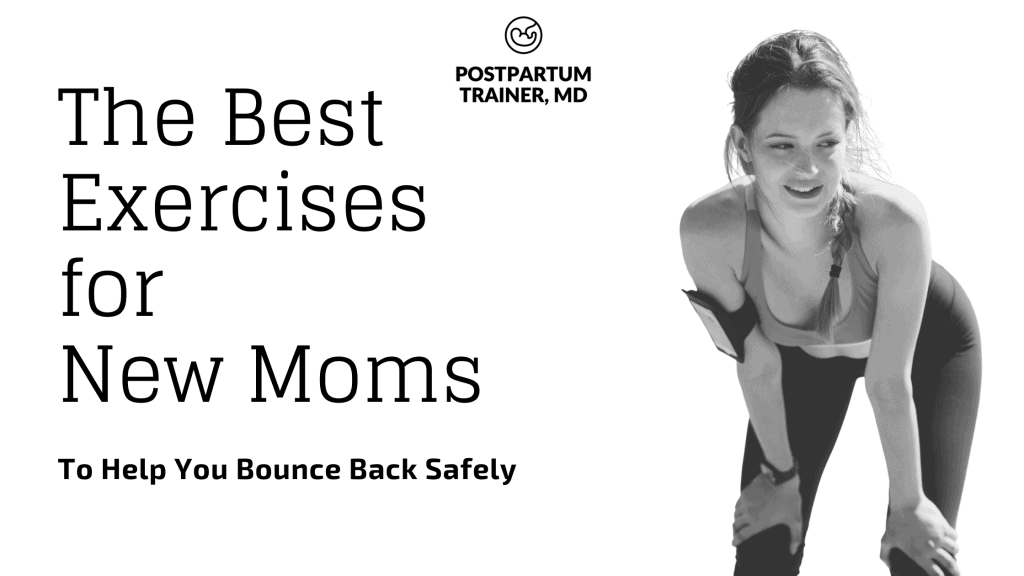
What exercise can I do after giving birth?
The best exercises for new moms are ones that will strengthen your core and pelvic floor in a safe and gentle manner.
Your body went through some amazing changes to grow a baby inside your uterus.
As a result:
- your core muscles are weakened as the abdominal muscles had to stretch to support the rapid growth of your uterus.
- your pelvic floor muscles get weak throughout your pregnancy as they are placed under a lot of stress in the antenatal and perinatal period.
Both of these happen regardless of the type of delivery you had. It doesn’t matter if you’ve had a vaginal delivery or a cesarean section, you will need to strengthen both of these muscle groups.
So let’s discuss the best low-impact exercises you can perform to start your postpartum fitness journey.
The Best Postpartum Exercises
Below, I will list out the best postpartum exercises in order of importance! We will start with the easier exercises and work our way up to the more difficult ones.
Part 1: Core & Pelvic Floor Exercises
The Kegel Exercise
The kegel is one of the most effective postnatal exercises to strengthen your pelvic floor muscles.
This exercise can be performed prior to pregnancy, during pregnancy, and in the immediate postpartum period.
You could perform kegel exercises from any position wherever you are, as it is more of an internal exercise that no one will ever know you are doing. 🙂
In this picture, I am doing it from the hands and knees position (quadruped position).
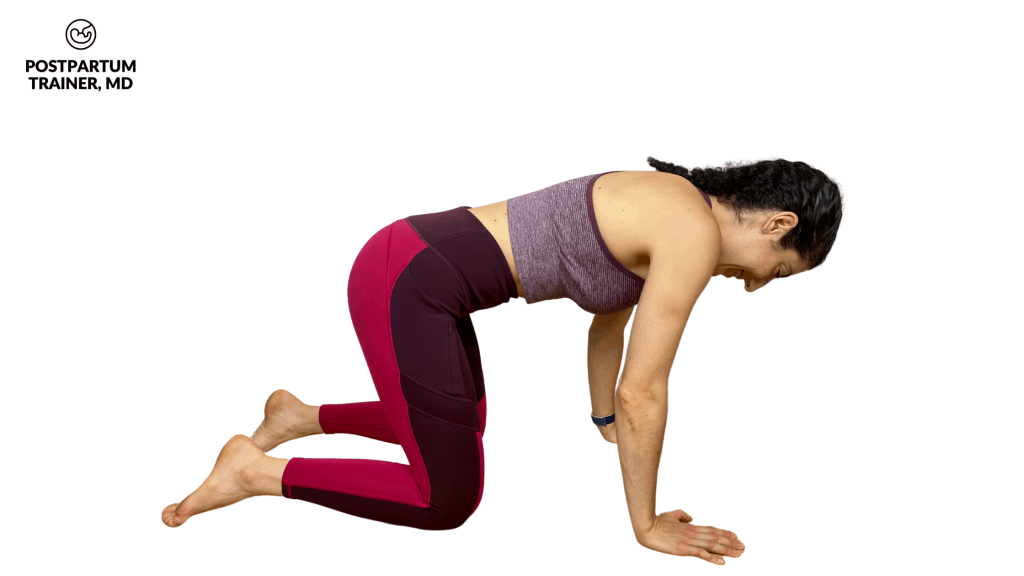
The idea is to squeeze the muscles in your pelvis and hold it for a 1-2 second count. Pretend as if you are trying hard to hold in your poop or stop a flow of urine.
Sorry for that graphic, but it’s the best way to teach it.
This is single-handedly one of the best ways to treat and prevent postpartum urinary leakage/ incontinence and pelvic organ prolapse. Studies show that pelvic floor training has benefits noted even 1 year after delivery.
You could never perform this gentle exercise too much. So feel free to do it whenever you remember.
Diaphragmatic Breathing
Diaphragmatic breathing is another great exercise to teach you how to activate your core muscles as you take deep breaths. It’s also one of the best introductory exercises for women with diastasis recti.
You see, many women breathe using their chest and accessory breathing muscles.
If you do this, you will typically see your chest rise and your shoulders shrugging.
This is not the most optimal way to breathe.
Instead, you need to learn how to breathe using your diaphragm to its maximum ability.
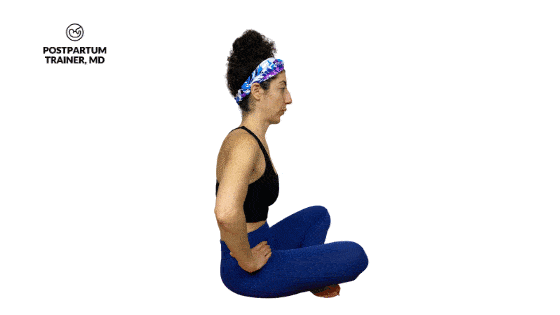
To do this exercise you can sit, stand, or even lie down.
It is best to put your hands over your abdomen as you take a deep breath. That way, you can get immediate feedback on whether or not you are doing it correctly.
At no point should your shoulders elevate.
Then, exhale as much as you can in a slow and controlled manner.
This will really help you to fully oxygenate your body while activating your core muscles.
Posterior Pelvic Tilt
The posterior pelvic tilt is another great exercise to activate your pelvic floor and core muscles in one easy movement.
This core exercise is best performed on the floor lying down on your back or against the wall.
Naturally, there will be a curve in your lower back when you are lying down or standing against the wall.
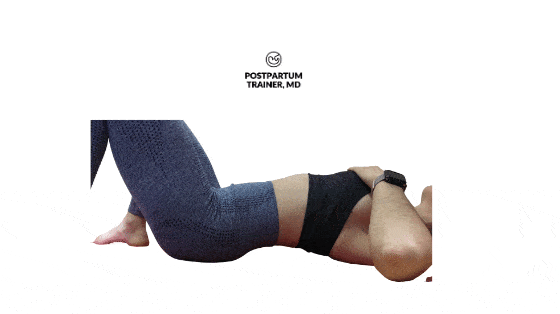
Ideally, you want to flatten that curve by squeezing your abs, glutes, and pelvic floor muscles.
Not only will this exercise help to activate your transverse abdominis muscles, glutes, and pelvic floor, but it will help to restore the anatomic alignment of your pelvis.
During pregnancy, your gravid uterus shifts your center of gravity forward. This tilts your pelvis anteriorly, creating what we call “mom posture.”
We want to reverse this as anterior pelvic tilt can manifest as low back pain. I go over more details in Postpartum Back Pain: What To Do About It.
Glute Bridge
The glute bridge is one of my favorite exercises.
It is super easy, you do not need any equipment, yet you really feel the burn in your hamstring and glute muscles.
The starting position is with you lying on your back with your knees bent.
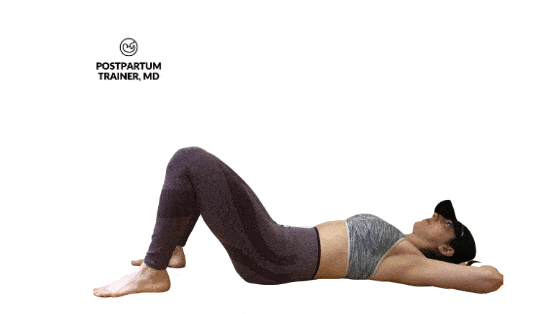
Next, you want to posteriorly tilt your pelvis so that you begin activating your core.
From here you want to squeeze your booty so that you can extend at the hips. In the end, you will have created a straight line from your knees to your shoulders.
Hold the top position for 1-2 seconds and then slowly lower yourself.
Walking
Aside from those gentle core and pelvic floor exercises, you could also walk!
Walking is one of the best, underrated exercises and one I strongly recommend prior to conception, during pregnancy, and immediately postpartum.
Walking helps:
- burn calories
- improve circulation
- decrease the risk of deep venous thrombosis, and
- strengthen the muscles of your legs
What’s even better is that you could walk with your baby!
I suggest walking 10-15 minutes per day at least 3-4 times per week.
So grab the stroller and get moving!
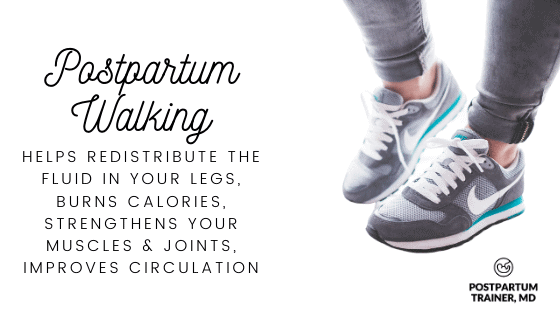
Part 2: Bodyweight Exercises
Secondly, you can begin incorporating some bodyweight exercises into your routine.
These are the best exercises to get your muscles and joints moving again in the early postpartum.
Before trying any of these exercises, be sure to get clearance from your healthcare provider first!
Here are the best ones:
The Squat
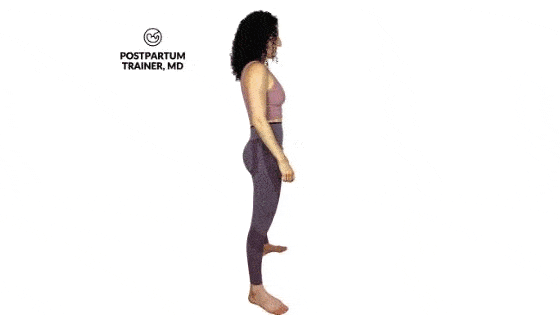
- The squat is the best exercise for the quadriceps, adductors, and glutes. Learn more in How To Squat Safely Postpartum.
Foot Assisted Dip
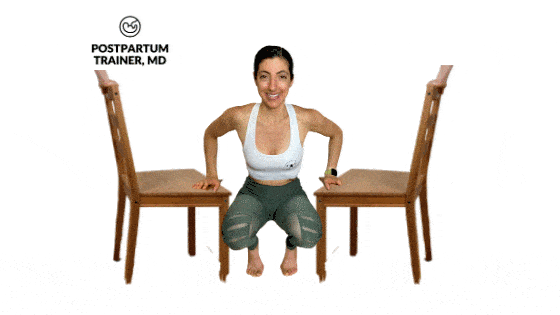
- The dip is one of the best exercises for strengthening and toning the arms, specifically the triceps, shoulders, and chest. I discuss this exercise in more detail in How To Get Rid of Batwing Arms.
The Reverse Lunge
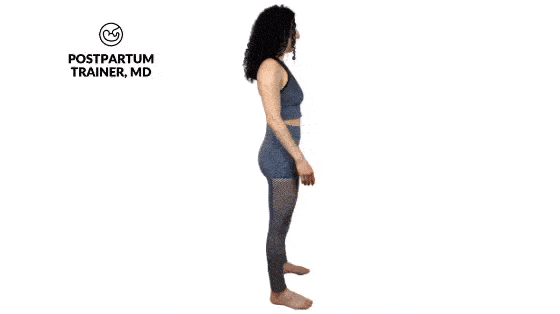
- The lunge trains balance, single-leg strength, stability, and core strength.
Wall Push-up
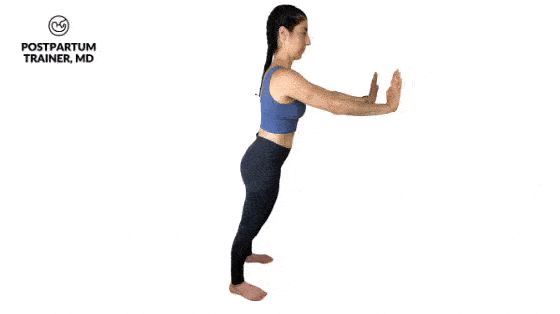
- The wall push-up is the best and easiest way to develop upper body strength. It targets the shoulders, triceps, and chest. I go over this push-up and other variations in Pregnancy Push-ups.
Part 3: Light Resistance Training
The third type of best exercise for new moms is resistance training. These will set the stage for you to restart strength training again.
Here are some of my favorites.
Band Pull-Aparts
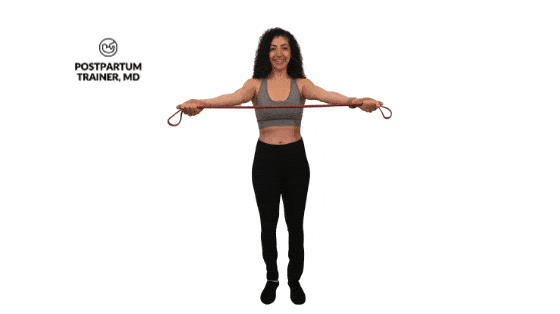
- The band pull-apart strengthens the upper back, posterior shoulders, and rotator cuff. Use a light/small resistance band. You can get a set here on Amazon.
Banded Kick Back
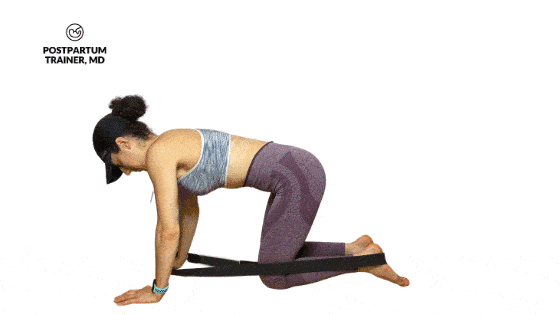
- The band kick-back trains the glutes, hamstrings, and core. It is best done with a medium/strong resistance band.
Dumbbell Overhead Tricep Extension
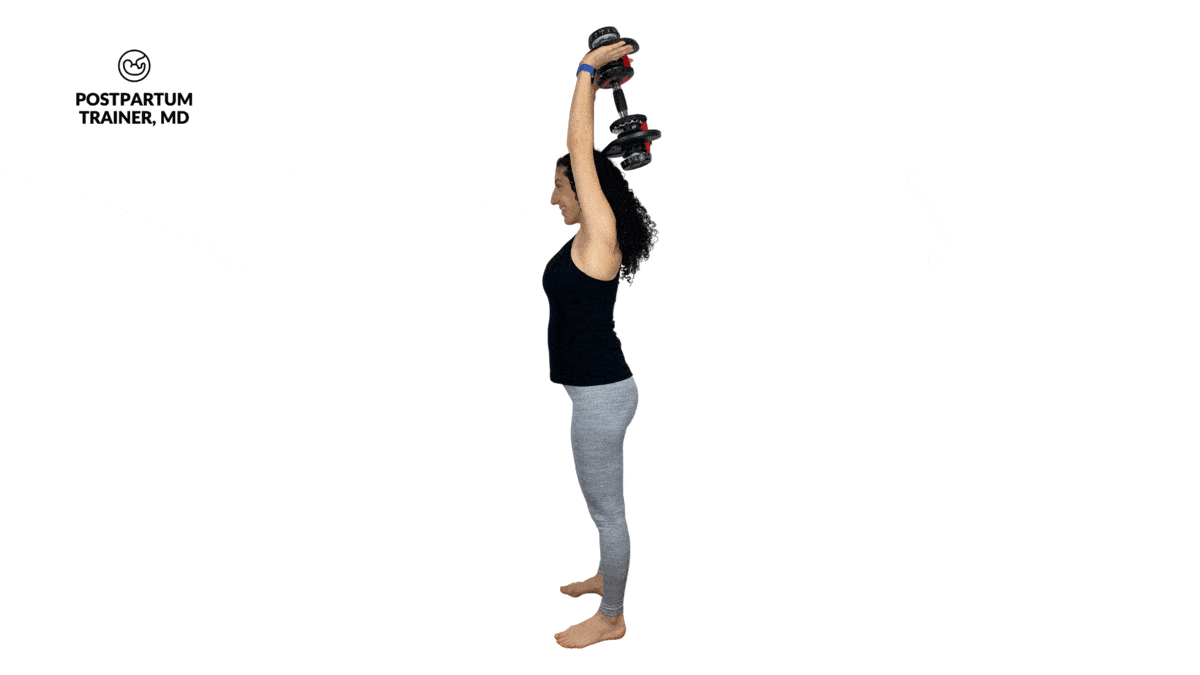
Another simple exercise to help strengthen the back of your arms is the overhead tricep extension. Just make sure to not arch your back excessively.
How soon can you start exercising after giving birth?
After a normal delivery, the general postpartum exercise guidelines state you should wait at least 4-6 weeks before starting any sort of exercise program.
However, it may be possible to exercise before six weeks postpartum, as long as you aren’t doing any type of intense exercise routines.
Always speak with your provider for personal guidance.
What exercises should you avoid postpartum?
In general, you should avoid any exercise that places a lot of tension or pressure on your abdomen.
This includes a lot of the traditional core exercises like sit-ups, crunches, and planks.
To learn more about what exercises you could do and which ones you should avoid, check out exercises you should avoid postpartum.
Are there any specific postpartum exercises to help tighten my stomach?
Reducing your mommy tummy is primarily accomplished through your diet.
Your diet is much more important than exercise when it comes to losing any amount of fat in your body.
That’s because you cannot spot reduce fat.
This means that you cannot do hundreds of abdominal exercises to try and get a flatter stomach.
I am not saying this to discourage you, I just want to set your expectations and help you understand this will require a lot of work.
To learn more, I have a detailed article explaining the mommy tummy and tips to get a flat stomach postpartum.
Tips on how to find time to work out as a new mom
Finding time to work out as a new mom can be difficult.
- You are exhausted.
- You don’t have anyone to watch your baby, and
- You need to do household tasks (cooking, cleaning, laundry).
But here are some tips to help you find the time.
Tip #1 Short workouts
Your workouts do not need to be long to get great results. In fact, they can be pretty short.
If you can do some type of activity 5 times per week, that’s only 30 minutes a day.
But if you can’t do 30 minutes – THAT’S OKAY TOO!
Something is always better than nothing.
Try to fit it in during these times:
- When your baby is sleeping or taking a nap
- When a friend or family member could watch the baby
- When your baby is in the swing
- You could even wear your baby and workout together
Tip #2 Integrate fitness into daily activities
You could also integrate some type of physical activity into your daily routine.
Instead of taking the elevator all the way up, get off 1-2 floors early and take the stairs.
Go for a walk when your baby is being restless instead of carrying him/her around the house.
Park further away so you could take advantage of the extra steps.
Take your dog for more frequent walks.
Do what you can, when you can!
The Best Postpartum workout plan (FREE pDF)
Alright mama, now I want to give you a free postpartum workout plan to get you started.
*Don’t forget to always check in with your doctor first before doing any type of workout program!*
Just enter your email to get the free workout routine.
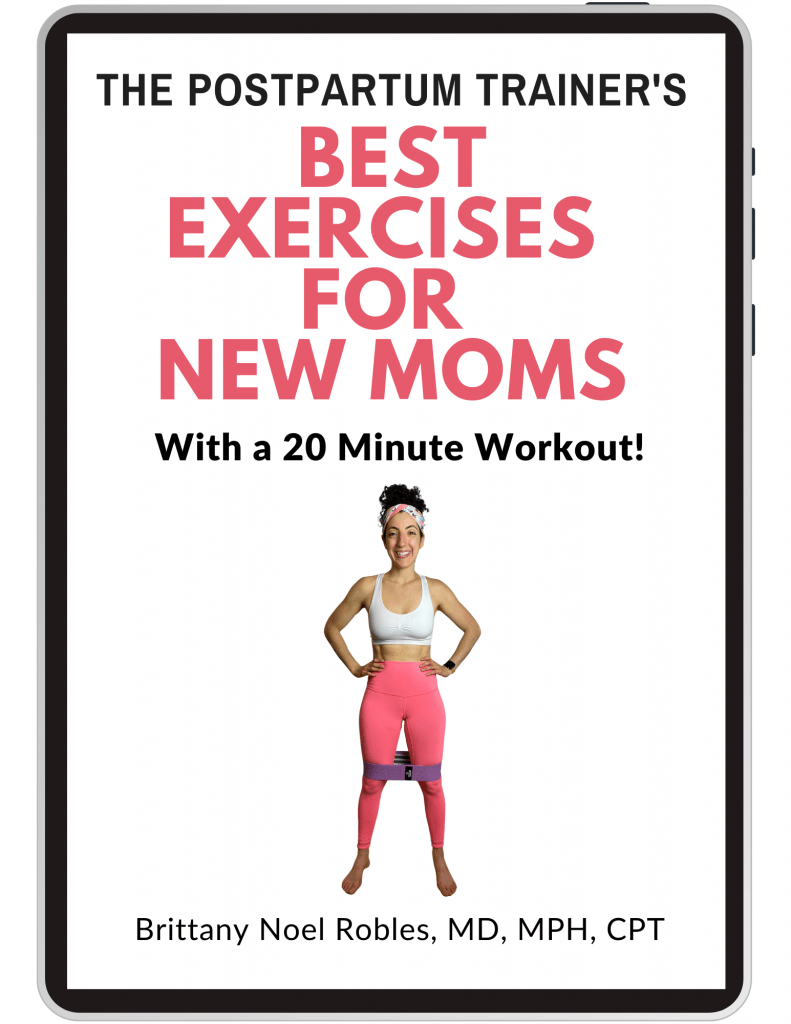
Final Words On The Best Postpartum Exercises
Postnatal exercise is so important!
It can help you lose weight, improve your postpartum recovery, decrease your risk of postpartum depression, and improve your overall health.
Use this fitness routine to help take care of your amazing body!
Now I want to hear from you.
What type of exercise are you most excited to try?
Has anything been holding you back?
Comment below and let me know!
Get Four Free Workouts To Help Strengthen Your Pelvic Floor & Heal Your Mommy Tummy!

Brittany Robles, MD, MPH, CPT
Brittany Robles is a full-time OBGYN physician, a NASM certified trainer, and a prenatal and postnatal fitness specialist. She holds a Master of Public Health degree in maternal health with a special interest in exercise and nutrition. She is also the co-author of The White Coat Trainer. Learn more about her here.
Sharing is Caring – Send This To A Mom In Need!
References:
- Mørkved S, Bø K. Effect of postpartum pelvic floor muscle training in prevention and treatment of urinary incontinence: a one-year follow up. BJOG. 2000;107(8):1022-1028. doi:10.1111/j.1471-0528.2000.tb10407.x
- Thabet AA, Alshehri MA. Efficacy of deep core stability exercise program in postpartum women with diastasis recti abdominis: a randomised controlled trial. J Musculoskelet Neuronal Interact. 2019;19(1):62-68.
- Poyatos-León R, García-Hermoso A, Sanabria-Martínez G, Álvarez-Bueno C, Cavero-Redondo I, Martínez-Vizcaíno V. Effects of exercise-based interventions on postpartum depression: A meta-analysis of randomized controlled trials. Birth. 2017;44(3):200-208. doi:10.1111/birt.12294

Thank you for these articles. I had 4 children in 4 years and now that my youngest just turned one, I see I need to make a lifestyle change. I’m frightened by how out of shape I am, and don’t recognize myself in pictures. Because I am so out of shape, I want to use the gentle postpartum approach to exercise so I won’t burn out and quit after a week.
Hi Laurel,
Thank you so much for your comment!
I really hope this workout keeps you engaged and can kick start your exercise routine to help you get back in shape!
Good luck!